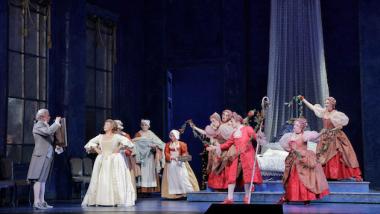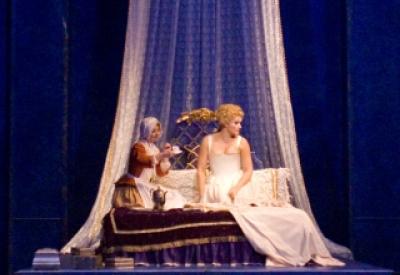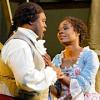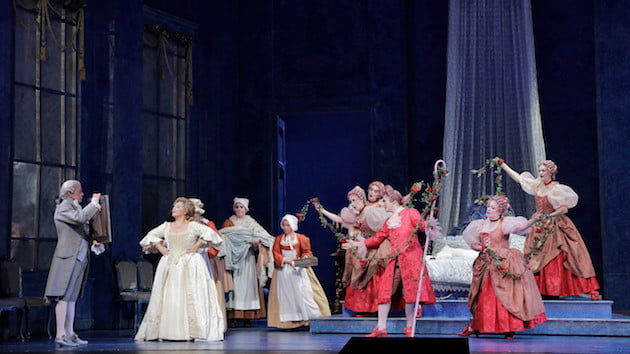
Love is the staple of Puccini’s operas — the radiant aria that marks love’s first flash, the gorgeous duet that pits two lovers against the wiles of the world, and the tragic closer as love succumbs to — and somehow transcends — circumstance.
In San Francisco Opera’s production of Puccini’s Manon Lescaut, which opened to a full house Friday at the War Memorial Auditorium, all the elements of that Puccini romanticism were there, with excellent lead singers, a fine conductor and excellent orchestra, and some captivating staging. And yet the love story somehow got left out. More on that later.
The source of Manon Lescaut, an 18th-century French novel already old in Puccini’s time, is part of the problem. On one hand, it tells of a romantic Liebestod (love-death), but it’s also a social satire, a critique of those many forces that work against romantic love. Puccini, who went through a half-dozen librettists trying to shape the story, unmistakably understood how difficult it was to set this opera — especially after the Paris success of Massenet’s version a few years earlier.
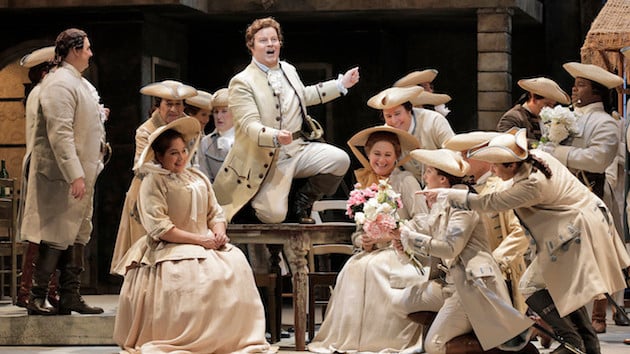
The beautiful teenager Manon, stopping at an inn with her brother on her way to be put in a convent, attracts two lovers at the same time: One is the rich tax collector and aging rake, Geronte de Revoir, who plots to steal her away to be his mistress; the other is the young Chevalier des Grieux, who (of course) loves her sincerely. Even though Manon’s brother tries to pimp her out to the old man, love wins out over lust — for a moment — and she runs away to Paris with her young lover. But as des Grieux inevitably runs out of money, Manon turns to the slimy rake, enduring a life of empty, Trump-Tower luxury. When her young lover reappears, she tries to flee with him, but Geronte, too savvy for them both, summons the police, who arrest her as a prostitute. She is sentenced to exile to the colonies (this is 18th-century France, so it’s Louisiana). Her lover tries to stage a rescue, but it fails, and he joins her on the ship to the new world. At the end, they escape from oppression in New Orleans, but Manon, exhausted and feverish, dies in the wilderness.
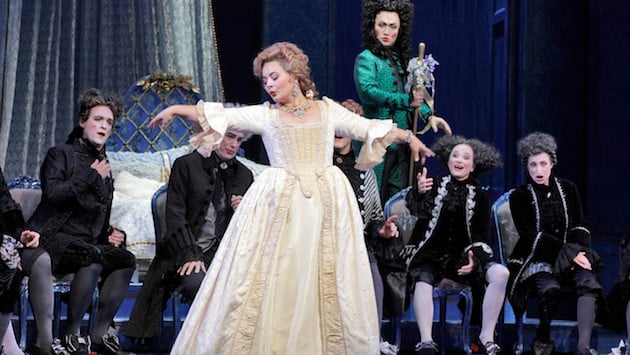
Soprano Lianna Haroutounian, in her role debut as Manon, was in superb voice from the very opening, reveling in her powerful and expressive high register. SF Opera fans already know her from her splendid performances as Butterfly in 2016 and as Nedda in the one-act Pagliacci last year; here, with a full four acts to fill, she showed her stamina and her sense of character, moving Manon from winsome convent-girl to proud courtesan with vocal and mimetic verve. A high point of the production was the extraordinary second act, in which Manon performs for her aged keeper and his ghastly coterie, all the while mocking the artificiality of the life he imposes on her.
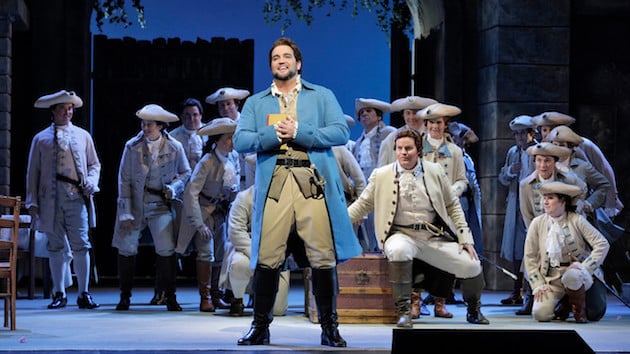
Tenor Brian Jagde, also familiar to SF Opera goers, made a passionate lover for Manon, giving a portrayal of ardent, unwavering dedication, well beyond the bounds of reason. His first act aria, “Donna non vidi mai” (I have never seen a woman), made it clear that des Grieux — previously scorning love — had, startlingly to us, and even to himself, entered a totally new life in falling for Manon. Jagde’s powerful tenor will be even more compelling when he finds a way to give more nuance with lower dynamics.
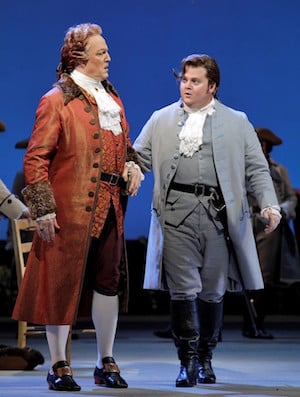 Philip Skinner
Philip Skinner
The orchestra was a main character in the drama: at times supportive of the lovers in their rapturous duets, at other times gleefully entering the ranks of love’s foes with a cynical sneer at romanticism. One could almost hear Shostakovitch in some of the brittle mockery of Act II. Former SF Opera music director Nicola Luisotti, returning to the pit for the first time after leaving his post in 2018, was warmly welcomed by the audience, and led with energetic tempi and sensitive rubato. The Act III intermezzo was especially moving, bolstered by a transcendent solo by principal cellist David Kadarauch.
The production, a reprise of a 2006 SF Opera presentation (starring Karita Mattila), was designed by Frank Philipp Schlössmann and directed by Olivier Tambosi, with mixed success. Act I, in the courtyard of an inn, with a chorus full of musical and dramatic energy, made superb use of space: Manon, alone and lost in her first appearance at the center of the stage, clutching a tiny suitcase, was an image that haunted the imagination.
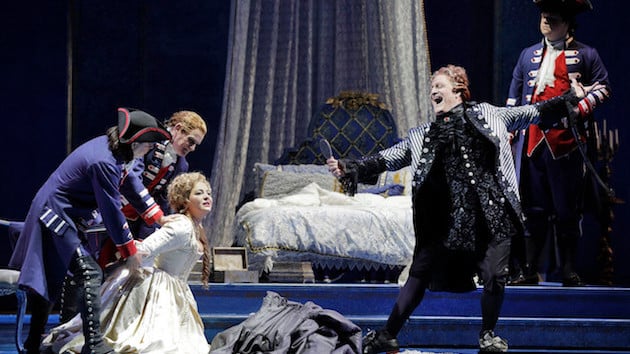
Act II captured the decadence of Geronte’s grand love-nest (a vast, deep-blue room with an enormous bed at the center). But when the focus turned to des Grieux’s passionate appeal to Manon to leave her bondage, the overbuilt set defeated any romantic closeness: The reunited lovers edged uneasily towards a grand bed that did not belong to them.
Act III, where des Grieux attempts to rescue Manon as she is led with the other exiled prostitutes to the ship for Louisiana (a very strange drama to begin with) was made even stranger by putting Manon in a peculiar window-cage while her lover sings to her from the back of the stage, behind another big piece of metalwork. The romantic connection was lost. Worse, Manon and her other courtesan-prostitute-exiles, one-by-one, were branded with red-hot irons: little chance for us to focus on romantic connections, with the stage dominated by such gratuitous violence.
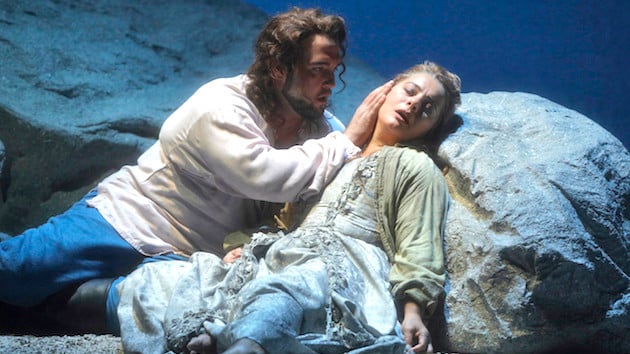
Most disappointing was the fourth and final act, as the lovers found themselves exhausted and helpless in the Louisiana wilderness: the desolation of their fate was figured in dry, pale rock formations against which the dying Manon, herself deathly pale, had to recline. She seemed defeated less by the circumstances of ancien régime patriarchy than by the gritty discomfort of stage boulders. Des Grieux did not make things better by his obvious reluctance to get close to his dying lover: while professing the greatest grief, and hearing her cry for him to hold her, he barely edged close enough to touch her shoulder: cold comfort for someone you have followed into a grueling exile.
This production, with so many wonderful qualities, was perhaps finally unable to meet the challenge that Puccini poses: how to imagine the tragedy of romantic love in the face of so many opposing forces. We might assert that, as Casablanca’s Rick Blaine has it, “the problems of three little people don’t amount to a hill of beans in this crazy world.” And yet, at least in opera — and most especially in Puccini — those problems, those little people, that love story do amount to something more than beans — or should.

